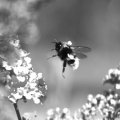A University of Queensland PhD student has developed a technique that can trace pollution and long-term changes to coral reef environments.
His study could provide the first insights from coral skeletons into how synthetic fertilisers, agricultural wastewater, and widespread land use change have altered nutrients and water quality since European arrival to Australia.
Guy Marion is examining the effects of human activities on water quality and the health of offshore coral reefs in the Mackay-Whitsunday region.
He is using his own geochemical tracer, known as Skeletal d15N, which can track historical nutrient sources and pollution. This can be combined with other tracers to develop records of increasing terrestrial discharge reaching coral reefs dating back several hundred years.
"According to recent evidence, most coral reefs worldwide were substantially degraded pre-1900," Mr Marion said.
"Increased terrestrial discharge laden with fertilisers, industrial sewage, sediments, and storm water have degraded the coral reefs of Queensland over the past 50 to 100 years. Yet the impacts of this remain controversial due to the absence of reliable long-term data describing water quality.
"Organic matter trapped within the skeletons of multi-century old corals may hold the key to understanding the nature and extent of human impacts and pollution on coral reefs."
Mr Marion`s research study is already attracting praise from the scientific community. In June he was awarded a prestigious $10,000 2004 International Society for Reef Studies and the Ocean Conservancy Fellowship.
The international student, from the US, is studying under the supervision of world-renowned coral reef expert Professor Ove Hoegh-Guldberg, who heads UQ`s Centre for Marine Studies. His co-supervisor is international geochemistry expert Professor Malcolm McCulloch from the Australian National University.
Mr Marion is currently putting his SCUBA diving skills to good use as he extracts coral cores and collects coral fragments ready for analysis in the laboratory.
"Pollution, along with overfishing and climate change, are considered the greatest of threats to coral reefs worldwide and are of particular concern in the Great Barrier Reef," he said.
"Manipulative experiments performed on the Great Barrier Reef will calibrate data recovered from coral cores, which record environmental change."
Mr Marion first developed the Skeletal d15N tracing technique while working on a project in Bali with ecological anthropologist Professor Steve Lansing.
"My contribution to the greater project was to figure out a means of tracing water quality change over decadal time periods, and use this to investigate whether excess fertilisers washing out to sea in agricultural wastewater might be accumulating in, and potentially damaging, coastal coral reefs," he said.
"Working with my supervisor Professor Rob Dunbar at Stanford University, we found that they were, and this finding is now part of the larger policy recommendation to reduce fertiliser usage Bali-wide."
The Great Barrier Reef Marine Parks Authority and the PADI Foundation are funding Mr Marion`s current research. He is also supported by an International Postgraduate Research Scholarship.
He said he hoped the study would become a blueprint for other researchers trying to understand the impact of human activities on coastal coral reefs.
"The issue of land-clearing and agricultural runoff on in-mid shore water quality and degradation of Great Barrier Reef corals is a contentious and highly visible problem in Australia," he said.
"I plan to set up a foundation dedicated to the preservation of coral reefs via the integration of sophisticated geochemical investigations and clear communication of methods and results.
"This should allow managers and politicians to legislate confidently with solid empirical data to support their decisions."
Media: For more information, contact Guy Marion (telephone 0412 490 841, email: g.marion@uq.edu.au) or Chris Saxby at UQ Communications (telephone 07 3365 2479, email: c.saxby@uq.edu.au).



